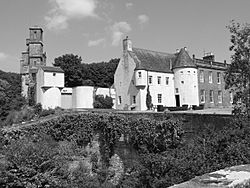Lauriston Castle, Aberdeenshire facts for kids
Quick facts for kids Lauriston Castle |
|
|---|---|
| St Cyrus, Scotland |
|

Lauriston Castle from the south
|
|
| Type | Courtyard castle with later additions |
| Site information | |
| Owner | Private |
| Open to the public |
Not open to public |
| Site history | |
| Built | 13th century onwards |
| In use | 13th century onwards |
Lauriston Castle is an old castle in Scotland, located on a cliff near the village of St Cyrus. It's not far from the North Sea. It used to be a royal fortress and is one of the oldest castles in the area still owned and lived in by private families. It's also a special 'listed building', which means it's protected because of its history.
Contents
Discovering Lauriston Castle's Ancient Roots
Long ago, people say Lauriston Castle was a strong home for King Giric, also known as Gregory the Great. He was one of the last kings of the Picts, an ancient Scottish people, around 878 to 889 AD. His church, Ecclesgreig, is close by. The village of St. Cyrus gets its name from his Latin name, Ciricius.
Lauriston Castle Through the Ages
The first official record of Lauriston Castle is from 1243. It quickly became a typical courtyard castle. It was heavily fought over during Scotland's Wars of Independence. In 1336, King Edward III of England made it stronger. He wanted it to be part of a chain of castles to stop the French from helping the Scots.
Over time, the castle changed. One of its corner towers, right on the cliff edge, became part of a typical laird's (landowner's) house in the 1500s. Later, this house was made even bigger. It became a large Georgian mansion with a Palladian design, built between 1765 and 1789.
The Straton Family and Their Legacy
For almost 450 years, the Straton family owned Lauriston Castle. Their family crest from 1292 is one of the oldest recorded in Scotland. A famous letter from 1320, called the Declaration of Arbroath, was sent to Pope John XXII. This letter, sealed by Scotland's earls and barons, has Alexander Straton's name as the last person to sign it.
The Sheriff's Kettle Incident
Another Straton, known as the "noble knight of Lauriston," died in the Battle of Harlaw in 1411. Soon after, his son was involved in a strange event called the "Sheriff's Kettle." The local landowners in Kincardineshire were unhappy with John Melville, the Sheriff. King James's Regent, the Duke of Albany, joked that he wouldn't mind if they "boiled the fellow and drank the broth."
Some barons took this joke seriously. They invited Melville to a hunting party. There, they put him into a large pot of boiling water. To show they were all part of the plan, they then drank the broth. This was a very unusual and harsh way to deal with a disliked official!
A Stand Against Church Taxes
The Straton family continued to do well at Lauriston. They even survived a big event in 1534. David Straton had a disagreement with the Church about paying tithes (a type of tax) on salmon he caught. He didn't want to give every tenth fish to the Church. He told his workers to throw the tenth fish back into the sea, saying God could catch his own.
Because he refused to pay these Church taxes, he was taken to Edinburgh. He was found guilty and faced a severe punishment. This made him one of Scotland's first people to be seen as a Protestant martyr.
Changes and Challenges for Lauriston Castle
In 1695, the Stratons had to sell Lauriston. The new owner was Sir James Falconer, a judge. Under the new agreement, the estate became a special area called a burgh of barony, with a free port at Miltonhaven. The name of the barony was even changed to Miltonhaven.
However, big storms in the 1790s destroyed both the port and the village. Because of this, Lauriston became known as "The Drowned Barony." Over the next hundred years, the castle grounds were designed in a beautiful, natural style. They included waterfalls, walking paths, and a large two-acre walled garden.
After its use as RAF barracks during World War II, part of the mansion was taken down. According to writer Nigel Tranter, the castle was in a very bad state.
However, Lauriston Castle saw a revival! Its Great Hall and Doocot Tower were rebuilt in the late 1980s. William and Dorothy Newlands of Lauriston led this work, using plans by architect Ian Begg. The doocot (a pigeon house) even won a special award in 1992 called the Glenfiddich Living Scotland Award.
Images for kids


